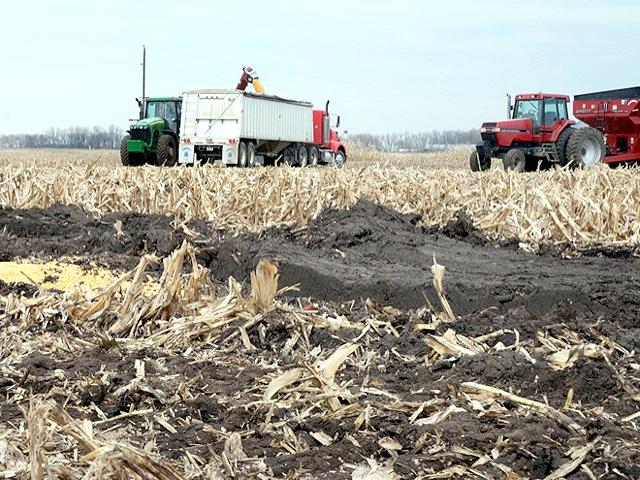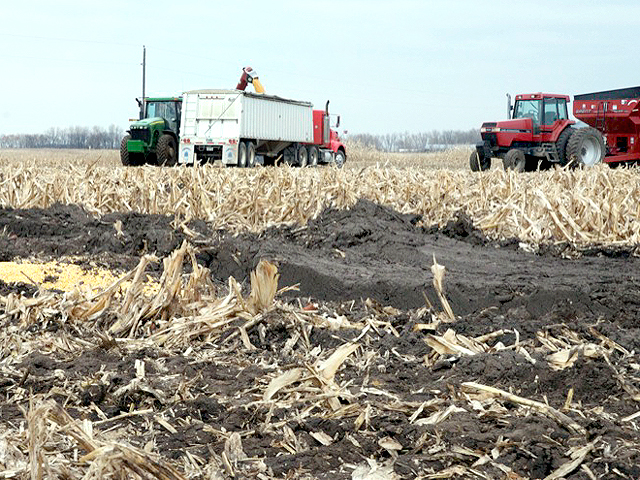Ag Weather Forum
Wet Fields: How is Soil Water Reduced and What Determines Its Rate?
Fall is when many producers look for warm, dry weather to help their crops dry down to the appropriate moisture content and to keep soil firm to bring equipment through without producing too much compaction. But the season is not always cooperative, as the transition from hot in the summer to cold in the winter brings about a clash of air masses that typically produce strong systems and, subsequently, good rainfall.
When soils do become wet or saturated, it takes time for them to drain. But what are the factors and processes that go into draining soils? There are several, and each one is different for a variety of reasons.
THE WATER CYCLE -- A BALANCED APPROACH
To start, let's look at the water cycle and dive into the soil's role to get a focused perspective on how water cycles through.
At the risk of being too science-y and bringing math into this article, in any mass balance equation, the current state of what you're looking for (in this case the amount of water in the soil) is equal to how much is going in minus how much is going out.
Water can go into the soil in a number of ways. The most obvious is from rainfall, which is the focus here. But you can also have water move into the soils from runoff of other places (think river flooding), condensing from dew or fog, or even come from the bottom up. When heavy rain occurs, it fills up soils to their capacity.
FOUR WAYS TO GET WATER OUT
To get water out of the soil, it is done in four main ways.
It can evaporate straight from the soil surface, be soaked up by plants (transpire), have runoff, or soak down into subsoils and groundwater for recharge (percolate). Runoff is easy to see -- watch it flow down your driveway into the street and down into a storm drain. Or wash through your gulley and into ditches.
The more even, not flat, your field is, the more even the effects will be. Areas with rolling hills will see the peaks dry out first, followed by the valleys and pits. This method takes care of the excess rainfall and leaves your field at saturation.
But to get rid of ponding and excess water within the soil, you're going to need the other three.
You cannot see the percolation, and it is a difficult portion of the equation to measure on the farm. Soil type, substrate type, temperature, and capacity of the groundwater reservoir are all factors that influence how quickly and how much water can drain out of the soil.
The sandier the soil, the quicker it will drain. That goes for the substrate as well. The more porous it is, the easier it is for water to flow through it and into the groundwater reservoirs and aquifers. But if soils are compacted, even sandy soils could take longer to drain.
Temperature is also a component. It is not that warm soils necessarily allow more water to percolate, but if the ground freezes, it will prevent or delay water from percolating.
And then, of course, if water tables are already quite high and aquifers are filled, soils do not drain as easily.
P[L1] D[0x0] M[300x250] OOP[F] ADUNIT[] T[]
That leaves us with some of the more interesting ways that water moves through soils: through the combination of evaporation and transpiration. We often lump the two together into a term called "evapotranspiration."
VARIOUS EFFECTS FROM EVAPOTRANSPIRATION
While evapotranspiration is usually combined in terms of numerical models and atmospheric science, on the farm, it is actually more important to describe each individually because soils are not always covered in vegetation.
Evaporation of water from the soil depends on several things, including plant coverage, soil type and organic matter content, soil temperature, air temperature, humidity, wind, and sunlight -- both duration and intensity.
The more "stuff" that is on the soil surface, whether it is from growing plants or stover, disrupts how moisture can interact with the atmosphere and evaporate. That's why gardeners use mulch outside of weed control. No-till practices are used for the same reason.
Sandier soils with less organic matter do not hang on to water as easily and are freer to evaporate. Darker clay soils hold on to water better, and therefore, evaporation is much slower. Additionally, the airflow between the soil particles in more dense soils is restricted and leads to lower evaporation.
Soil and air temperature combine with humidity to all have a similar effect. Warmer air can hold more water vapor. As soils and the air warm up, humidity between these two decreases, thus allowing more evaporation.
Strong winds continually bringing drier air across a wet surface will help to dry it out. It is why you use those annoyingly loud hand dryers in the restroom.
And all of this can be influenced by the sun, both the time of day and time of year and also with cloud cover or obstructions. Energy from sunlight can be used to excite the water molecules themselves, or heat up the air and ground, causing the humidity to decrease. I am sure you have noticed the difference in drying between a shaded area and one that is sitting in the full sun. Clouds and other obstructions limit the amount of direct sunlight to cause evaporation. Also, the longer the day, the more energy available to evaporate water from the soil surface. I'll talk about the seasonality of that down below.
But for transpiration, important influences are the growth stage of the plant, air temperature, and sunlight -- things that overlap with evaporation -- and a reason why the two are often lumped together.
Farmers know that the water requirements are different for each stage of growth. The larger the plant, the more water it requires for photosynthesis. But then the plant will also have deeper roots to draw more moisture out. More often, when plants are in their reproductive stages, transpiration is maximized because instead of just leaves transpiring water vapor, corn silks, soybean stigma, stamen, anthers, and petals all require additional water to operate. And during the fill stage, water is required to transport sugars to the fruit, where it is usually locked in until the plant starts to die. But during these final stages of growth toward the fall, transpiration decreases.
Plants require more water when temperatures are higher to help regulate temperatures and photosynthesis. The same is true with increased sunlight, which obviously has a seasonality to it. The more sunlight that occurs, the more water that the crop will demand. Extended days of cloudiness, smoke, or haze can have an impact too, as the reduced sunlight slows photosynthesis.
SEASONAL DIFFERENCES IN WATER REDUCTION FACTORS
So not only do these factors listed above have an impact on the amount of water that drains out of the soil, the relative importance and strength of the factors can change depending on the time of year. The easiest way to think about the seasonality is by temperature and sunlight.
For a lot of these factors, the closer to winter it is, the colder it is, the less sunlight there is for evapotranspiration, the less likely there are plants to drain soils, the slower the soil will drain.
But closer to the summer solstice, sunlight is maximized. It occurs for longer periods of time and is more intense, speeding up evapotranspiration. Temperatures are higher and relative humidity is lower between the soil and the atmosphere, and plant surfaces and the atmosphere.
But is there a direct link between spring and fall and the amount of drainage? Taking all things into consideration, there is none that I can find. And finding a black-and-white yes-or-no answer is seemingly impossible, given all the factors that can influence how soils drain.
A study published in the Journal of Japan Society of Engineering and Geology seemed to suggest that evapotranspiration was higher in spring than in fall, but their goals were focused on how evapotranspiration changed with sunlight during different seasons and did not list the ambient temperature, which may have had an influence. The four dates they chose to cover the four seasons also did not coincide with similar day length with regard to the solstice or equinox, which also has an influence.
You can find that study here if you are interested: https://www.jstage.jst.go.jp/….
HUMAN INFLUENCES ON SOIL WATER
Of course, humans can do many things to influence the water cycle, especially with regard to agriculture. To keep more moisture in the soil, one of the best ways to conserve moisture is to use a cover crop or go to a low-till or no-till soil management practice. But there is only one effective way to get water out of the soil, and that is through tiling.
The use of drain tile has become an important part for some parts of the world that historically have had issues with saturated soils. And with climate change expected to produce more significant flooding events in the future, tiling will be an even greater tool to use to hasten the impact during those events. Tiling is more effective in those areas with high water tables that stay wet longer.
The IPCC spells out the current evidence for increased heavy precipitation events in section 3.3.2 in this release here: https://www.ipcc.ch/….
CONCLUSIONS ON WATER MOVEMENT
Essentially, the answer to the question of when your soil will drain is "it's complicated." All the factors I listed in the article are not independent of each other. They sometimes influence each other and can increase or decrease the rate that water moves out of the soil.
But you can be sure of a few things:
1. It takes longer for water to leave the soil and allow fieldwork when you have fine-textured soils with lots of organic matter when it is cold out, away from the summer solstice, and in a valley with lots of ground cover and little plant growth.
2. It takes less time for water to leave soils when soils are coarse-textured with little organic matter during the middle of a hot summer day, with a stiff wind, in full sunlight on a tiled hill either with bare ground or rapidly growing plants.
3. Even these factors described above have nuance for your field, and you are the better judge of when you will have the ability to get back into your field to either plant or harvest.
John Baranick can be reached at john.baranick@dtn.com
(c) Copyright 2021 DTN, LLC. All rights reserved.






Comments
To comment, please Log In or Join our Community .